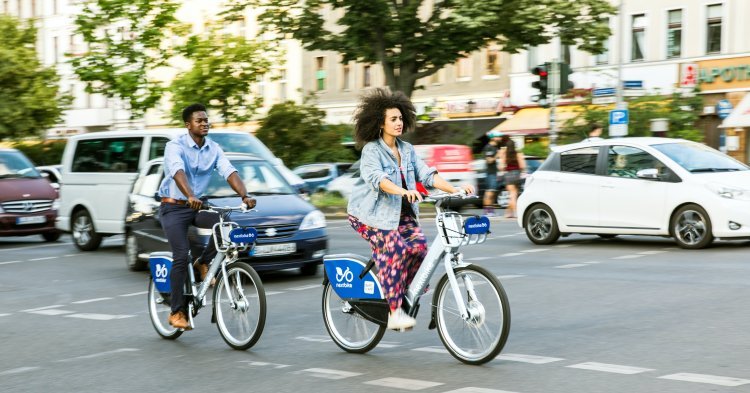Turns out, the fundamental law of traffic works on bicycles as well as it does on cars and other vehicular traffic. The law states that adding more lanes to a highway or increasing road space doesn’t decrease the traffic density, but rather increases it. This is because people feel compelled to drive on this road more often than before, and for longer distances.
According to a recent study published in Proceedings of the National Academy of Sciences, this law is true for bicycles as well. Increasing bicycle-friendly infrastructure can increase the number of bicycles on the roads.
“We expected that more infrastructure leads to substantially more cycling,” said Sebastian Kraus, the study’s lead author. “However, for bikes, this empirical pattern has been less well documented than for cars. It was interesting to see that even cities that are not known for cycling can transform themselves into cycling cities really fast.”
Kraus’s team observed 106 European cities, including Paris, Lyon, Stuttgart, Budapest, and Dublin. In their research they studied data from cycle counters and pop-up bike lane road work projects. They found building cycle lanes increased cycling in those cities between 11% and up to 48% on average.
Even though most streets allow cyclists to ride alongside cars, the study shows that dedicated lanes make a huge difference. The most likely explanation: safety.
Countries like the Netherlands, which prioritise cyclists’ needs when planning infrastructure, have a higher percentage of their population who cycle regularly for short distances. The Netherlands has extensive and well-managed bike paths, which are well used by the community: as 36% of Dutch people list the bicycle as their most frequent way of getting around.
“Previous research has shown that making cycling safe is key to allow those ‘interested but concerned’ to cycle,” said Kraus, a doctoral candidate in economics at the Mercator Research Institute on Global Commons and Climate Change in Berlin. “The Netherlands has shown that dedicated cycling infrastructure that is properly separated and protected also allows kids, older people or even people in electric wheelchairs to move around autonomously.”
In the UK, many local authorities built pop-up bike lanes out of converted car lanes during the pandemic. Policymakers wanted to decrease the demand for public transport and reduce congestion by promoting cycling. Often they removed dense bottlenecks, where previously cycling was perilous. (In 2019, 98 people in the UK died from accidents involving bicycles, while the number of pedal cyclists killed or seriously injured in Great Britain has increased by 11% in the past ten years.)
The paper estimated that in Germany, these bike lanes could generate between $1 and $7 billion in health benefits per year, especially through reduced medical bills. “Each kilometre cycled brings half a dollar cent in such benefits according to the medical literature”, Kraus said. “When you multiply this with the increases in cycling from our study you end up with these high numbers, which make pop-up bike lanes almost a no-brainer from a cost-benefit perspective”. Furthermore, the new infrastructure may generate between $2.2 and $6.9 billion every year if the new bike lanes become permanent and make cycling habits stick.
After the pandemic is over, these pop-up bike lanes could face the risk of being torn down by city officials and local councils. The idea that removing bike lanes will leave more room for cars and hence more traffic, is well-intentioned, but misguided at that. If that occurs, Kraus is concerned that these trends of increased cycling may not be permanent.
“We know that people change their mobility habits when they need to experiment (eg- pandemic, having kids, etc). The rest of the time, mobility habits are sticky. So there’s a good chance that people will continue cycling”, Kraus said. “However, that’s probably only going to happen, if the infrastructure stays. Many cities are making the pop-up bike lanes permanent, but some are rolling them back, sometimes also driven by claims that not enough people are using them. That’s where we wanted to make a contribution: We show that pop-up bike lanes work.”
In December, London’s Borough of Kensington and Chelsea removed the protected bike lanes that had been in place for nearly two months, citing opposition from businesses and residents. However, an independent survey saw that most residents supported bicycle lanes, including having them on main roads.
Switching from cars to public transport or better yet, bicycles, is incredibly beneficial for the environment. The average petrol car on the road in the UK produces the equivalent of 180g of CO2 every kilometre, while a diesel car produces 173g of CO2/km. But bicycles have added benefits that public transport cannot compete with. This study has shown the massive health and economic benefits of an increase in cycling.
“Not all people can afford cars”, Kraus said. “People on bikes need little space and energy and create few external costs like air pollution, noise, and accidents or, which is currently particularly important, infections for others. And it’s even better for the remaining people in cars because there will be fewer traffic jams. Removing bike lanes could fire back by creating even more congestion, because people may see no other choice than getting a car as well.”

Follow the comments: |
|
